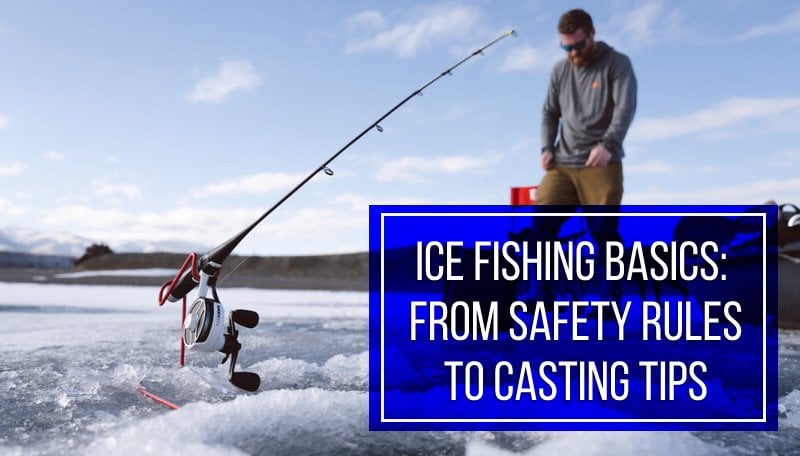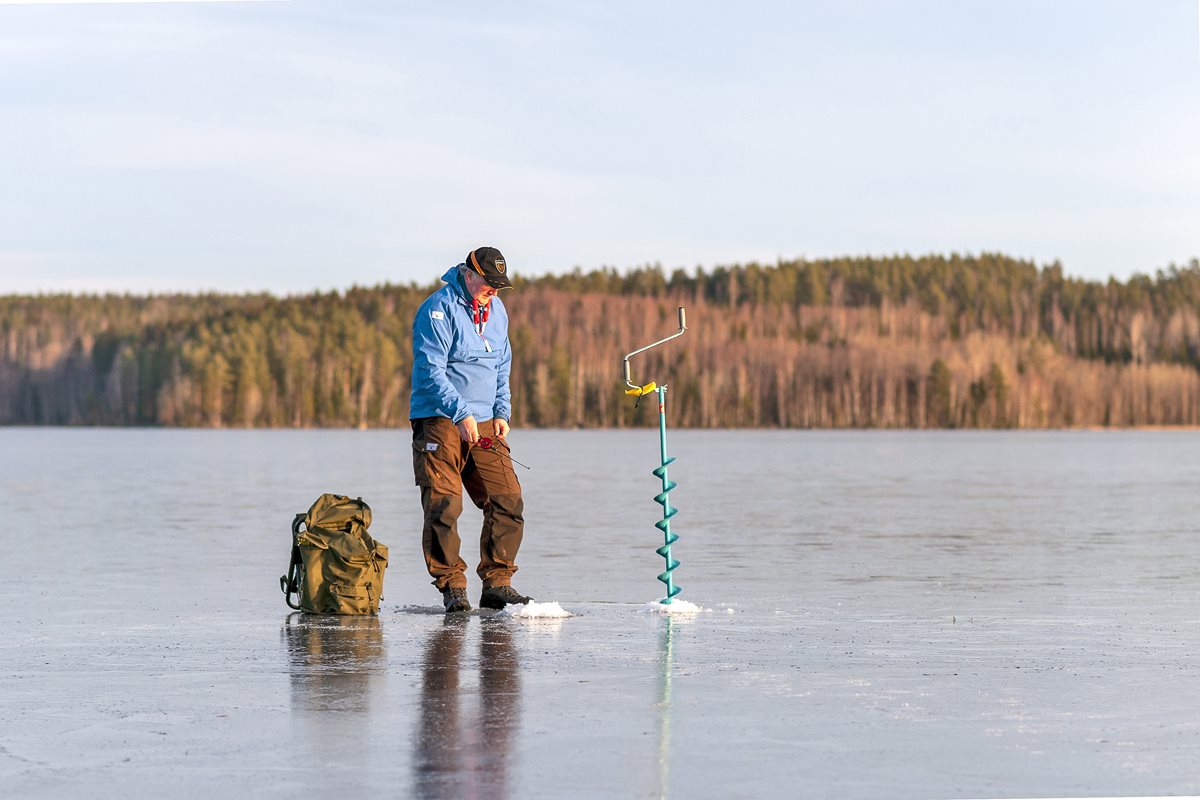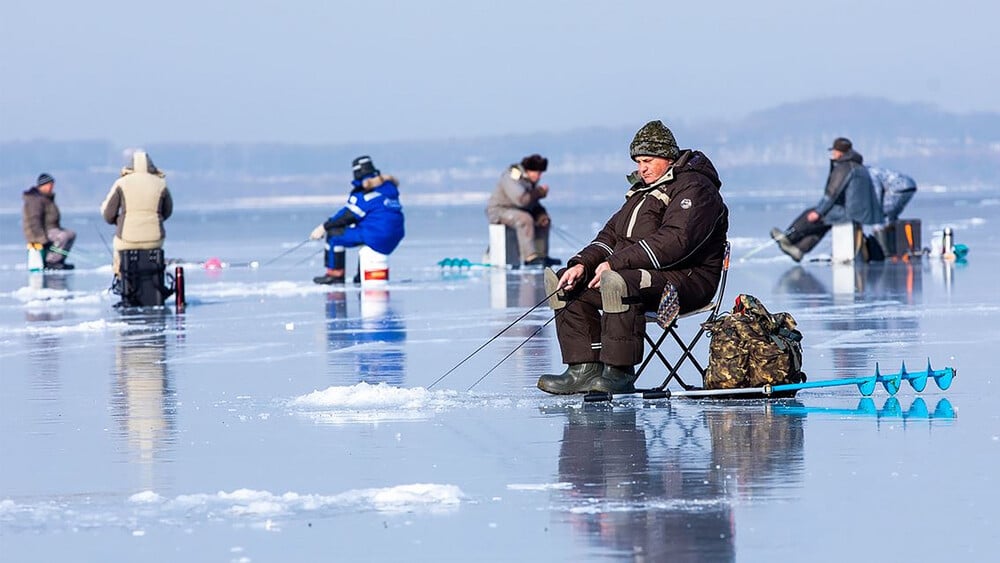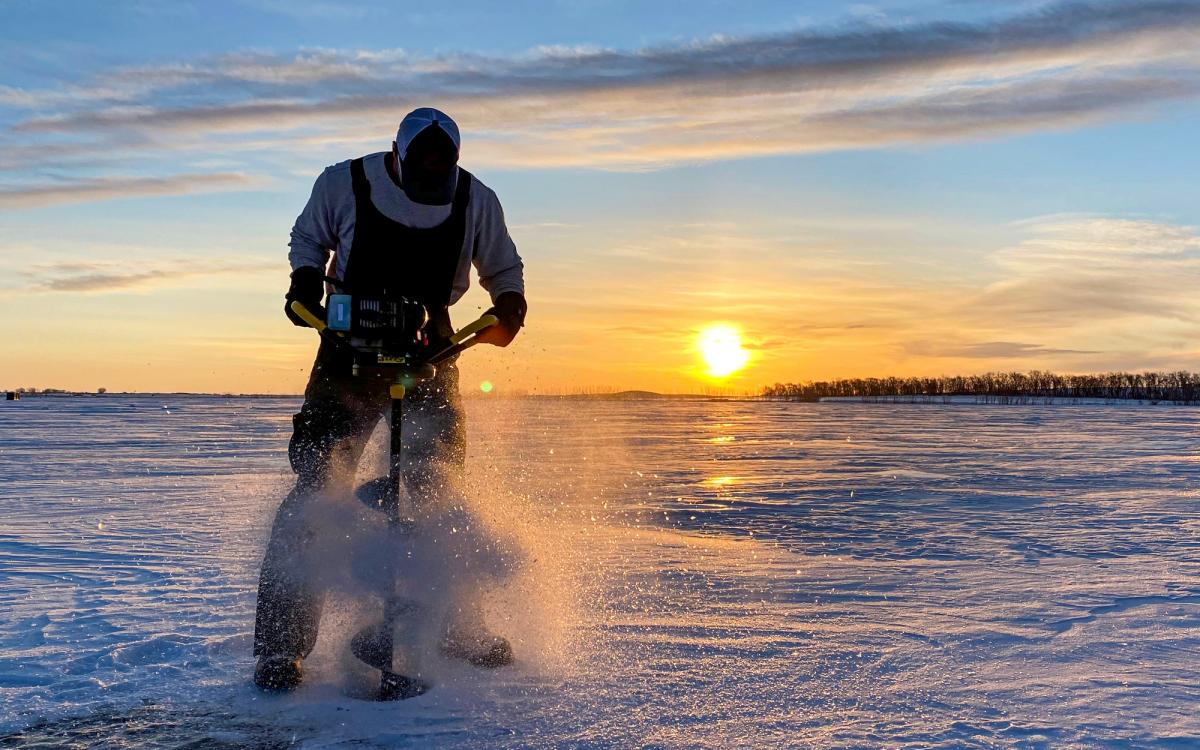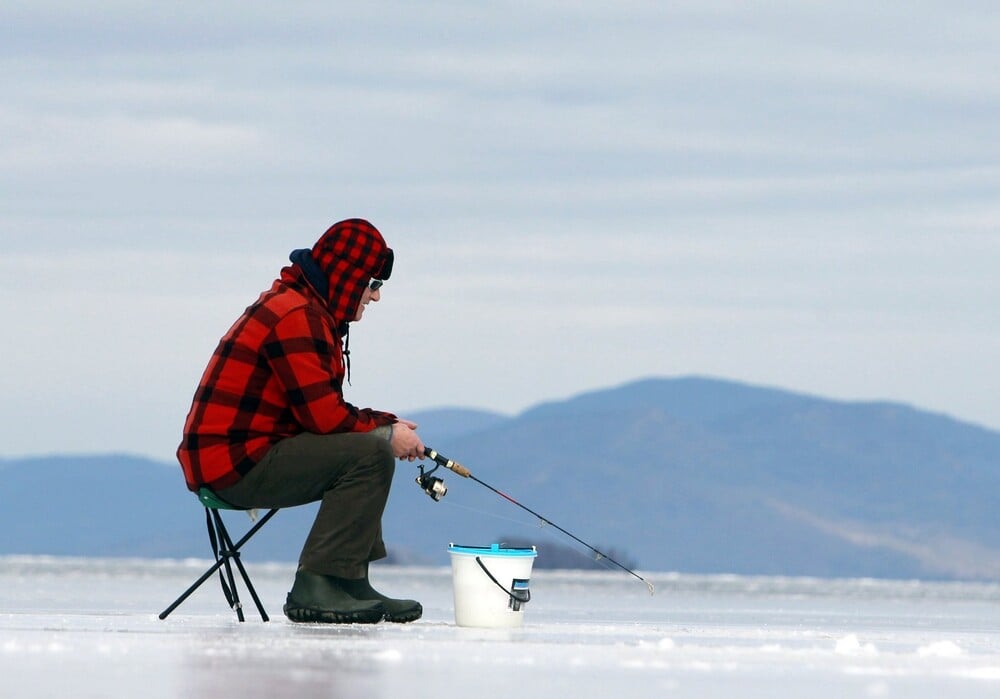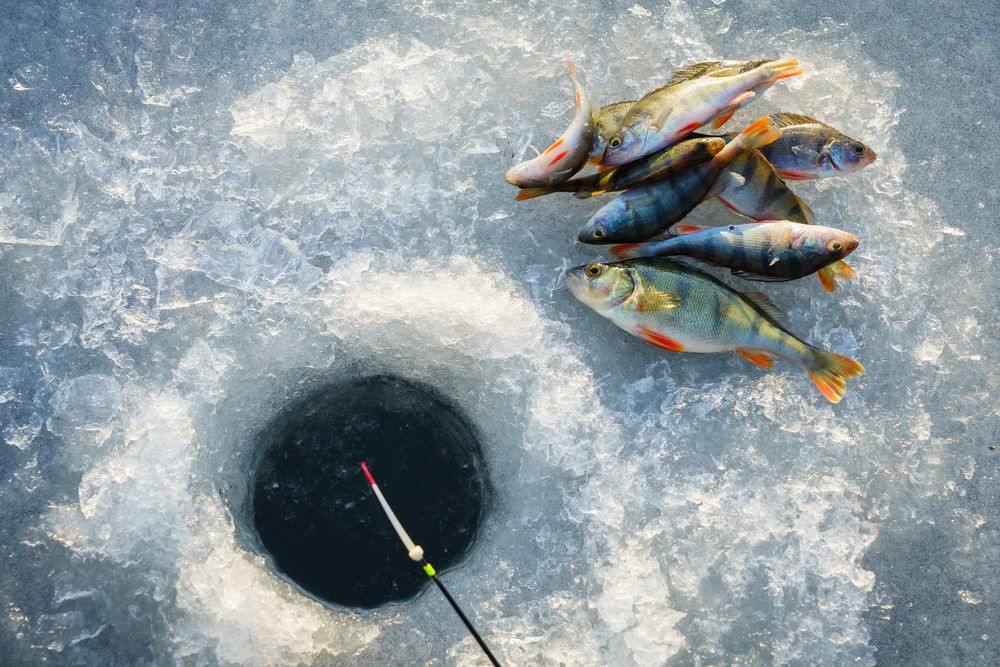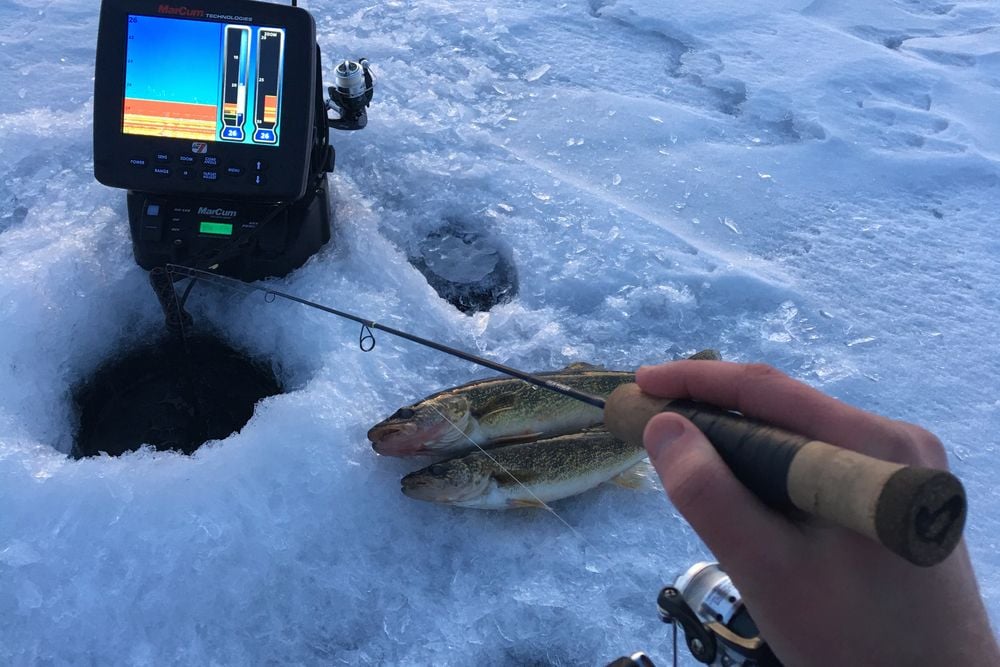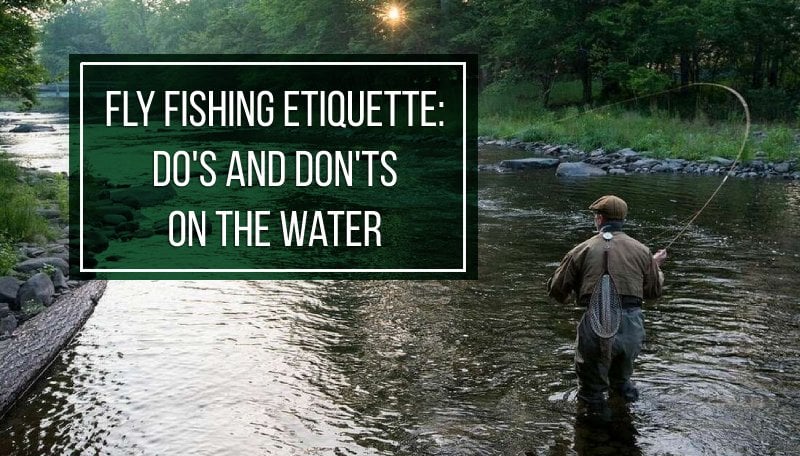Last Updated on
Winter is often perceived as the time when nature falls into a deep slumber, covering every nook, however well-hidden, with a veil of idleness. As it descends to capture lakes and ponds in icy shackles, most anglers hang up their rods and wait out the cold months until spring. But life never stops below the ice. Why not continue fishing even during the coldest time of the year? Ice fishing is cherished by many anglers who were curious and risky enough to give it a try. Like the Lady Cold itself, it captures the still beauty and tranquility of winter while allowing you to land the catch of your dreams. Ready to give it a try? Then let’s dive into the world of ice fishing. Don’t hold your breath, for we have a portable air pocket.
By the way, if you want to learn more about fly fishing etiquette and how to be respectful and courteous on the water, be sure to follow the link and read our post.
Table of Contents
Safety Comes First
Dressed For the Occasion
Things to Have at Hand
Time to Set Off
Ice Fishing Techniques
Tip-up Fishing
Jigging Fishing
Conclusion
FAQs
Ice Fishing Safety Rules
One of the reasons why some anglers take a winter break is safety. Indeed, while ice cover presents new opportunities, it also creates hazardous terrain that has claimed too many lives. Ice can be conniving and treacherous, but only if one doesn’t know how to read its signs.
The thing is, ice does not freeze uniformly, and its thickness varies depending on several factors like water currents, temperature and cycles of freezing and thawing. It is therefore crucial to ensure you check the ice’s thickness before stepping foot onto it. A rule of thumb is that ice must be at least four inches thick for safe walking and eight to twelve inches thick to support the weight of a car or small truck. How are you supposed to know its thickness? An ice auger is an indispensable tool for every ice angler. By drilling a hole close to shore, you can check the thickness of the ice before getting far enough to be at risk.
You can also rely on the color of the ice as an auxiliary sign. As a general rule, clear blue ice is the strongest and safest, while gray or white ice may be weaker. This is because clear ice forms when the water freezes slowly and has fewer air pockets, creating a solid sheet. On the other hand, white or gray ice may have air bubbles, snow, or slush mixed into it, making it weaker and less reliable.
However sure you might be of your ice-examining skills, there is one rule that is to be observed all the time. Much like a thin ice cream cone that melts quickly, thin ice can quickly crack and break under pressure. Wearing a personal flotation device will save your life should ice treacherously crack under your feet. You should also use an ice chisel to check the area in front of you as you proceed.
Dressed For the Occasion
Everybody dresses for winter, and ice fishing calls for an even more thought-through approach to your dressing style. You won’t move around as much, so the task of keeping you warm lies with fishing apparel. This task is of paramount importance, so we suggest you don’t skimp on your clothing.
Layering is the primary principle of outfit-building for wintertime. You don’t want to put on tons of sweaters and pullovers to eventually drown in sweat. Start with a moisture-wicking base layer that will keep sweat away from your skin, preventing chilling during inactivity. On top of that, add an insulating layer or two (fleece or wool) to keep the heat in. Finally, wear a wind- and waterproof outer layer for protection from the elements and any splashes from drilling holes. For your lower part, a base moisture-wicking and an insulated layer will suffice.
Next, make sure your extremities are covered. Insulated boots with thick socks will keep your feet warm and dry. Look for ice fishing gloves with a good grip that will allow you to handle your equipment easily. Don’t forget a fishing hat as well- it’s estimated that up to 50% of heat can be lost from your head, so keeping it covered is a must.
Things to Have at Hand
Your equipment is your most trusty companion. Unless you fish with friends, and then it’s only one of them. Equipment addresses every need an angler might have and basically allows them to do what they do. As such, it should be carefully picked so that you have a tool for every situation you might face.
Safety Equipment: We said it once, we’ll repeat it. It’s better to return empty-handed than not to return at all. Safety should always remain your top priority. Put on a lifejacket or flotation suit or acquire a jacket with in-built flotation solutions (Striker Ice is particularly known for those). Don’t forget about ice picks and whistles: the former will give you more traction during your self-rescue attempt, while the latter will notify anyone in the vicinity about your misfortune. Remember, preparation is key to avoiding dangerous situations or escaping them should they take you aback.
Ice Auger: This pal has also been mentioned in the article, but there is no ice fishing without him. Checking the thickness of ice is only one of the primary functions of an ice auger. This device grants you the fastest and most convenient access to the fish in the form of a hole. There are hand-powered or gas/electric varieties, so choose depending on your preference and budget.
Ice Fishing Rod and Reel: While a regular fishing rod might seem adequate, the conditions of ice fishing are somewhat peculiar. Ice fishing rods are built for those conditions: they are shorter and more sensitive to lure strikes that are often less perceivable in winter. Pair it with an ice fishing reel, and you’ll get a dependable setup for cold-weather fishing.
Tip-ups: Want to maximize your chances of landing a catch? Consider using ice fishing tip-ups! These devices alert you when a fish takes the bait, allowing you to cover more ground instead of stalking a single ice hole.
Ice Fishing Shelter: Ever wondered how anglers stay warm during hours on the ice? The secret lies in portable ice fishing shelters. They protect from wind, snow, and cold, and are a must for any dedicated ice angler. You never know when strong wind might kick off and shelter will allow you not to retreat at first signs of weather getting worse.
Ice Fish Locator: Locating fish in regular water is not particularly easy, but doing so in winter is even more complicated. Fish locator saves you time by telling you the most optimal place to fish in. It may also show you how the fish reacts to lure presentation.
Best Time for Ice Fishing
First, let’s talk about fish behavior. Just like us, fish are influenced by their environment, and understanding how they react to seasonal changes is critical for angling success. In winter, fish become more lethargic due to the colder water temperatures, making them less active and more likely to stay close to the bottom. That is why mid-winter is the least preferable time for ice fishing. At the beginning of winter, many fish species continue to feed like they would in late fall. Fish also sense spring approaching and somewhen near March become active once again. Those times of year are most optimal for ice fishing (when the is already or still strong).
At the same time, even lethargically sluggish fish still need to eat. That’s when you come in. The best time to go ice fishing often revolves around capitalizing on fish feeding patterns, which can vary depending on the species. Here are some examples of fish species that are most commonly caught during ice fishing:
Walleye: Often considered the holy grail of ice fishing, Walleyes are known for their elusive nature and excellent taste. They are most active during low-light conditions, making early morning and late afternoon prime times to target these species.
Yellow Perch: These striped beauties are a favorite among ice anglers for their abundance and delicious flavor. Yellow Perch tend to feed throughout the day, but mid-morning and late afternoon often yield the best results.
Northern Pike: The fierce Northern Pike is an ice fishing heavyweight, with anglers eagerly awaiting their chance to reel in one of these predators. They are most active during daylight hours, so plan your trip accordingly to increase your chances of a successful catch.
Trout: Ice fishing for trout can be a thrilling endeavor, as these cold-water dwellers are known for their acrobatic displays when hooked. Targeting them during the late afternoon or early evening will give you the best shot at landing one of these prized catches.
Ice Fishing Techniques
Now to the tastiest part. What exactly are you supposed to do, dressed for the weather, with all the necessary equipment lying near you, ready for action? There are two main techniques ice anglers utilize: tip-up fishing and jagging. They are not opposed to one another as one of them is a luring technique, but it’s best you know the nitty-gritty of both of them.
Tip-up Fishing
A tip-up is a device that alerts you when a fish takes the bait. It features a spool filled with a tip-up fishing line and a trip mechanism with a flag that serves as the marker. The technique of using tip-ups revolves around suspending your bait at a specific depth to attract the attention of the fish and then switching to more conventional means of catching. Here’s how to set it up:
- Drill a hole in the ice with an auger.
- Assemble your tip-up, threading the line through the spool and attaching a leader, hook, and bait.
- Lower your bait to the desired depth (try targeting weed beds or drop-offs where fish are likely to congregate).
- Set the flag mechanism and place the tip-up over the hole.
- Keep a watchful eye on your flags and be ready to spring into action when one goes up!
Remember, tip-up fishing is all about patience and covering more ground. Spread your tip-ups strategically, and don’t be afraid to experiment with different depths and locations.
Jigging Fishing
Jigging is an active form of ice fishing that will allow you to actually get it out of the water. At the same time, it can be used to both beckon fish and catch it. This technique requires you to perform constant lift-fall-pause rod movements. Follow these steps to master the jigging dance:
- Rig your ice fishing rod with a suitable jig or lure (think small, as fish tend to have smaller appetites in winter).
- Lower your jig to the desired depth, often near the bottom where fish are more likely to be found.
- Begin the jigging motion – a rhythmic up-and-down movement that mimics the natural movement of prey.
- Vary your jigging speed and cadence, as well as the length of your pauses, to find the sweet spot that entices fish to bite.
Jigging is all about finesse and experimentation. Don’t be afraid to switch up your lures or jigging patterns until you find what works best for the fish you’re targeting.
Conclusion
And that’s how you ice fish, more or less. Of course, this guide only gives you a general idea of what ice fishing entails, but it can serve as a solid foundation for your further research. Or maybe you didn’t find any aspect of this activity particularly fascinating and made up your mind to never try it. That’s also fine, ice fishing might not be a thing for everyone. And yet, if the topic piqued your interest, we encourage you to consider the possibility of trying ice fishing at least once. And we will be happy to provide you with things you might need.
FAQs
Why would anyone go ice fishing?
Despite the cold and a bit of apathy that winter brings, ice fishing is still worth a try. It requires a different approach to a well-known activity, a different set of equipment and different techniques, so it might bring variety into your warmer-season fishing routine (and get you out, if you don’t fish during winters.) It also presents fishing opportunities unobtainable in other seasons. And no bugs are messing with you. If that doesn’t sell you ice fishing, nothing will.
What month is best for ice fishing?
March is generally considered to be the best time for ice fishing, but early winter can also make for a great ice fishing period. The thing is to catch fish while it’s either still active before a more rigid winter or becoming active as spring approaches.
How many inches of ice is safe to fish on?
The minimum thickness of ice that is safe to fish on is four inches. The more the better, but less than that is literally dangerous. Remember it’s not you alone that ice is supposed to hold. You’ll bring your equipment and compromise the integrity of ice by drilling a hole in it. You want to make sure it can withstand all that.
